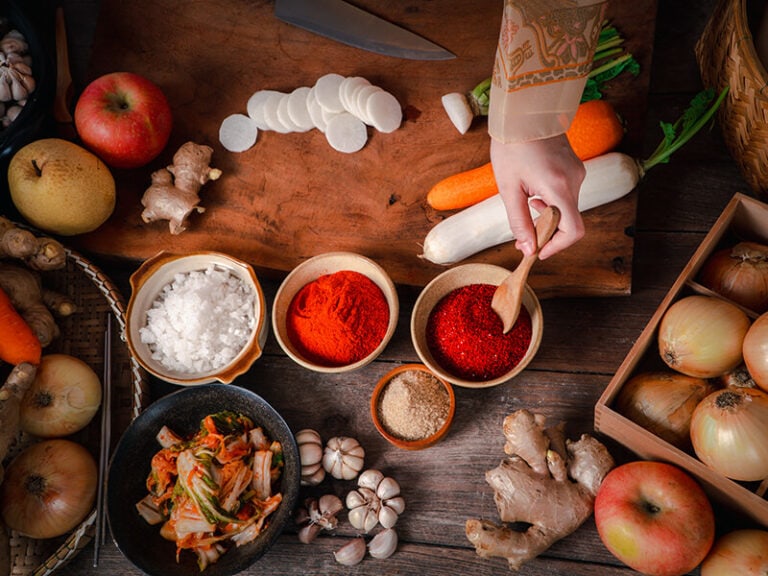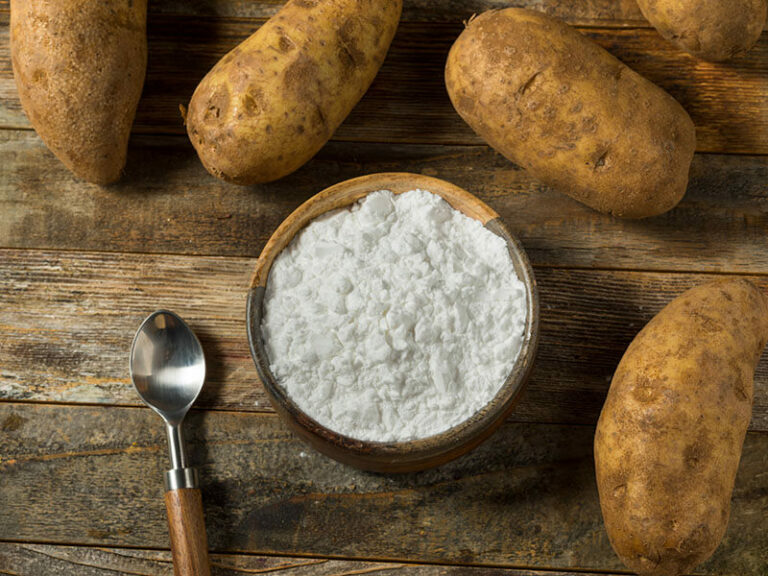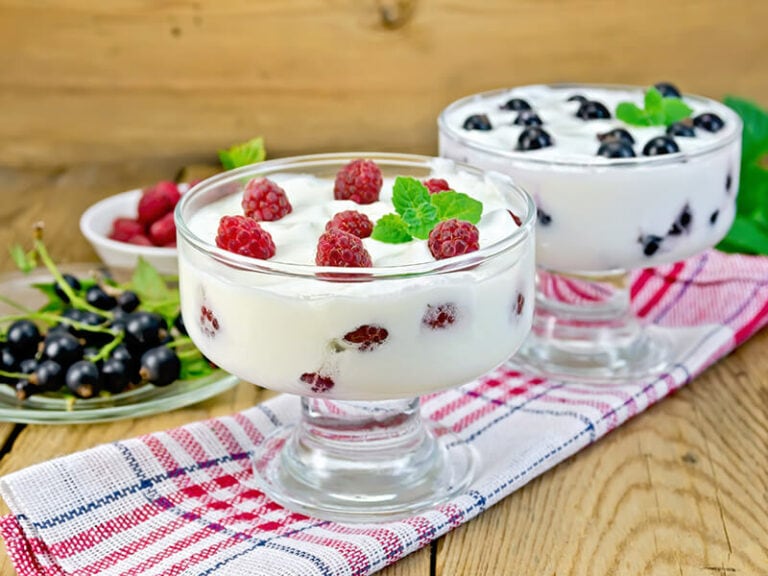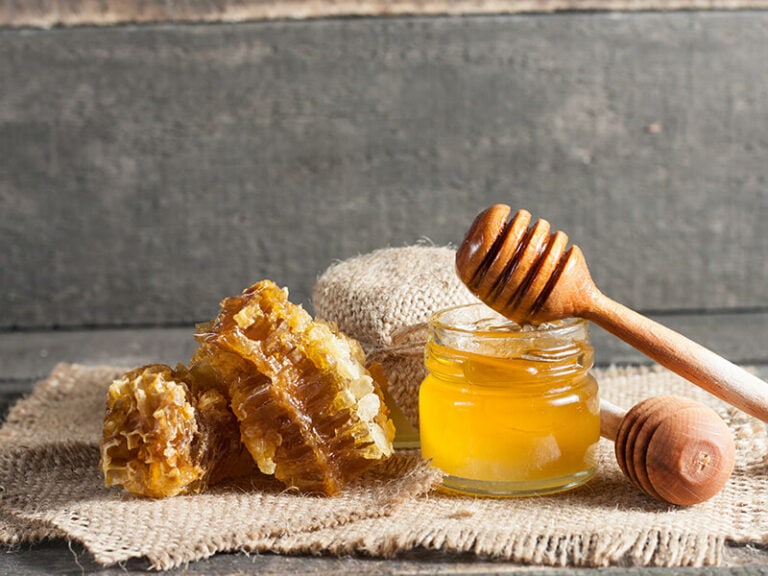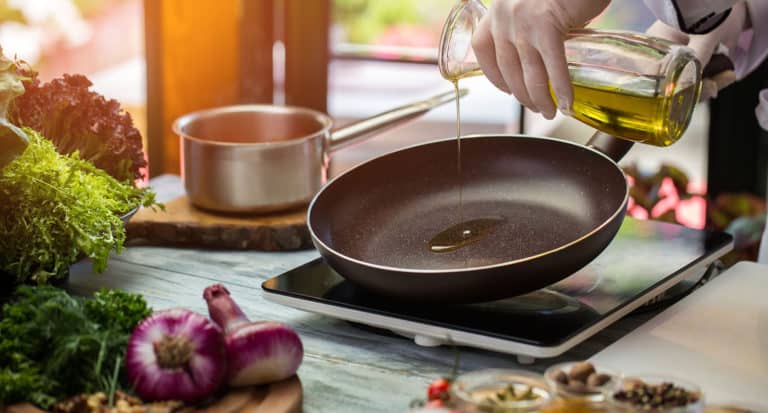The Dutch oven vs. the stock pot matter is hard to weigh up. Almost every family uses either or both of these two cooking appliances. Which one would be better if you were to compare them?
Although, many similarities between the two, you can tell them apart in many ways. Choosing the ideal thing for various cooking methods is an undertaking.
You will learn new and intriguing information in this post, including features and applications for them. Let’s take a look.
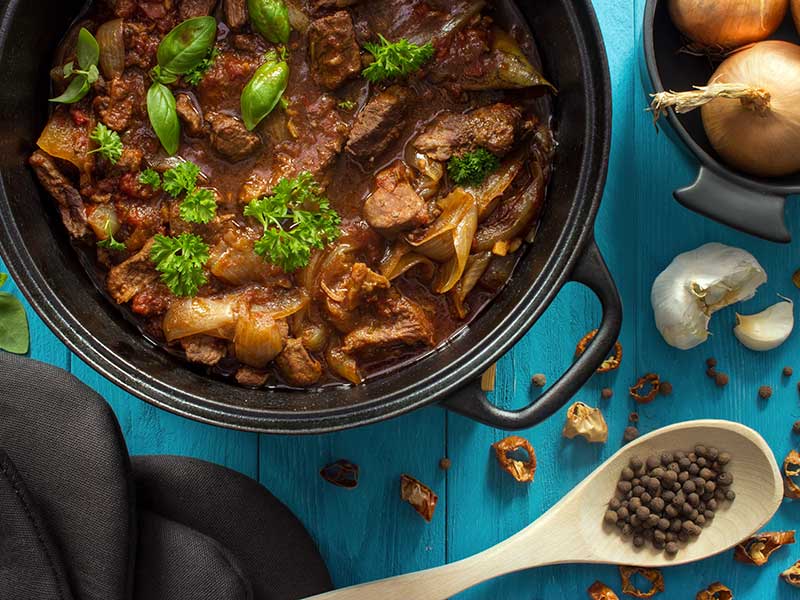
All About Dutch Oven – Something That You Know
The presence of a Dutch oven is high in the kitchen of every modern family. People use it every day because of its convenience. So why is it so popular?
History Of Dutch Ovens
The Dutch oven is from the beautiful Netherlands, though the British also played an important role. In the 17th century, instead of producing expensive kitchen utensils from copper and brass like his peers, an English craftsman named Abraham Darby had another idea.
In the hope of creating cheaper cookware, he and his colleagues had learned a method of casting iron in a sand mold from the Dutch. After many failures, they finally succeeded in creating a new type of cooking pot. So it is the reason why people call the Dutch oven.
The new type of pot was quickly introduced to the market and immediately became popular thanks to having the same quality as costly brassware but at a cheaper price. (1)
There are quite a few questions surrounding the origin, and shape of Dutch ovens, but you will find the answers here.
Unique Features Of Dutch Ovens
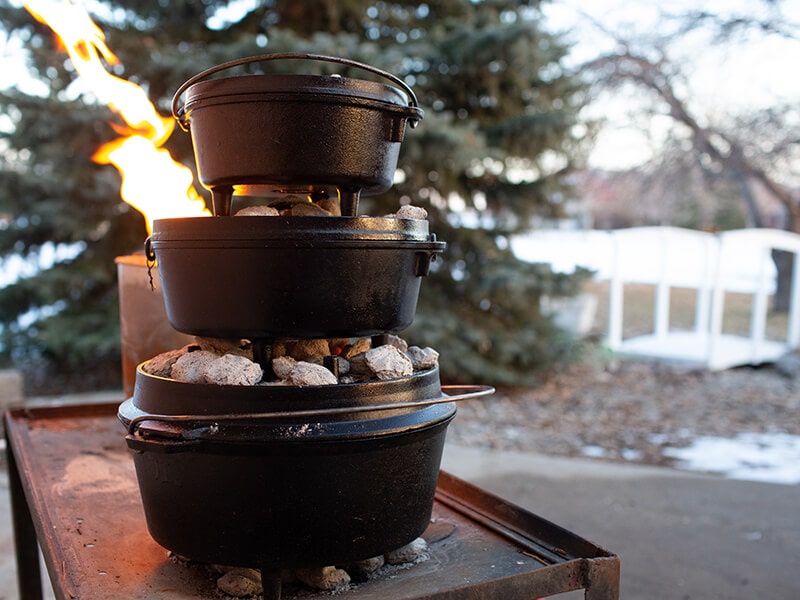
Dutch ovens have a simple shape. It is a round pot with a lid. But in reality, it is much more than that. The Dutch oven is a pot with thick walls and a tight-fitting lid.
It is made of thick cast iron. However, with the subsequent improvement in technology, many products are now cast in aluminum, stainless steel, or ceramic.
With sturdy materials and a tight-fitting lid, the Dutch oven satisfies the requirement for cooking on a flame. To make them non-stick, people also coat them with enamel.
Today, there are various variations of Dutch ovens. Some are used for campfire cooking or to glaze. Dutch ovens contain three built-in legs, a wire bail handle, and a curved lid. They are often referred to as campaign or cowboy-style ovens.
The ability to stack Dutch ovens while they cook is an intriguing innovation. It helps you save the most time while preparing many dishes at once. You can stack 5 to 6 pots on top of one another. It allows the heat from the pot below to cook the one above.
Dutch Oven Uses
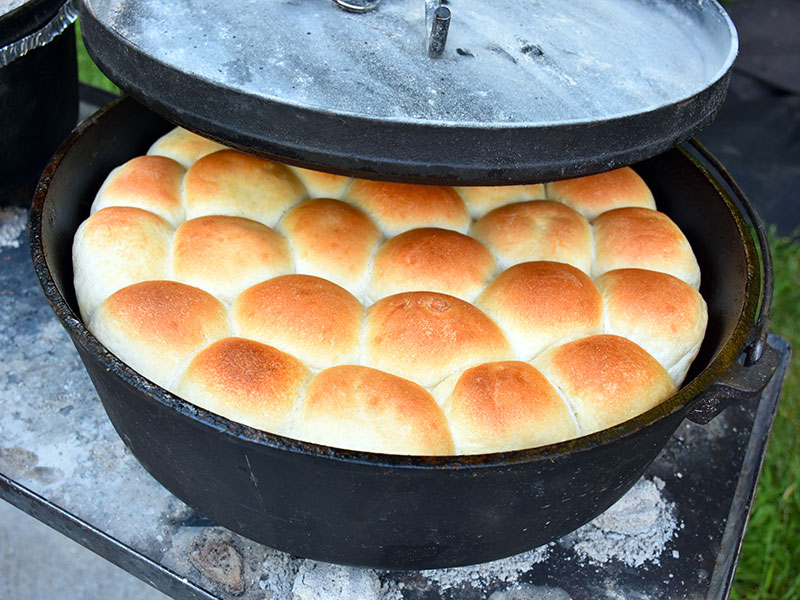
With a thick design, the Dutch oven is suitable for long, slow cooking. Beans, vegetables, or casseroles will be deliciously cooked until tender in it.
Plus, its versatility accommodates virtually any recipe cooked in a conventional oven. Baking, frying, or braising can be done with a Dutch oven.
What Does The World Call A Dutch Oven?
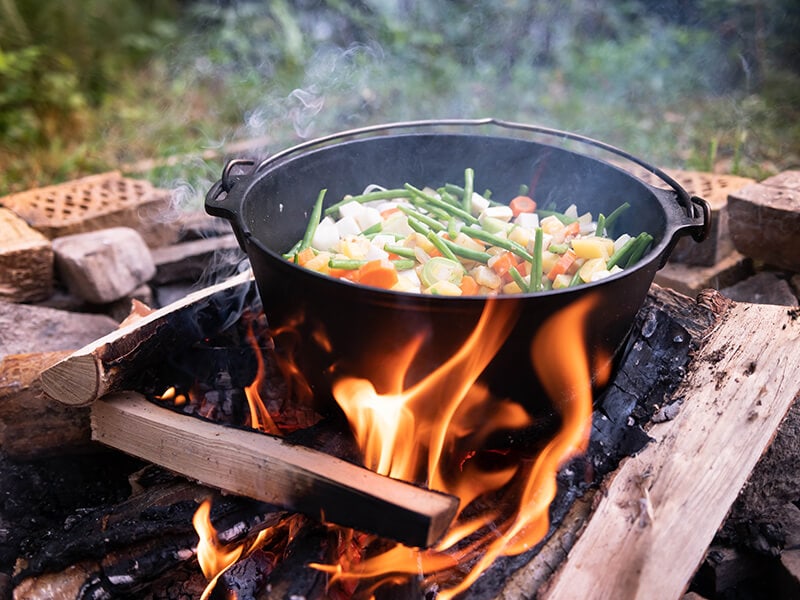
Due to their convenience, Dutch ovens are gradually gaining popularity in many cultures. A few different concepts and names for Dutch ovens that you may not have heard of.
The first example is in Eastern Europe and Central Asia, where they use a pot shaped like a Dutch oven, called a Chugunok. In Russia, for example, they designed it into a kiln without a handle and used it to cook over an open flame.
In South Africa, people here call a pot to cook on fire or coal like a Dutch oven “a potjie“. Potjie means “small pot”. There are also many other “variations” of Dutch ovens designed to suit the characteristics and purposes of use in each country.
The Bedourie oven is an Australian version of the Dutch oven. Made of mild steel and less brittle than cast iron, it will not easily break when dropped. That is how the sheep and horse herders working at Bedourie station invented it.
The strangest thing, however, is probably how the Dutch call their Dutch oven. Called braadpan in the Netherlands, a Dutch oven roughly translates to a roasting pan. Another interesting name is sudderpan, which closely means simmerpan.
Brief Overview Of Stock Pot – What Is It Exactly?
Besides the Dutch oven, the stock pot is a vital gadget for every kitchen. However, many housewives see them as another form of a Dutch oven. If you are one of them, you should scroll down below to learn more.
Stock Pot: A Long-Established Invention
The stock pot is the common name for one of the most popular cooking pots worldwide. Because of such familiarity, it is difficult to pinpoint the exact time that the first stock pot appeared.
During the stages of human development, many types of materials have been used to make pots. Ceramic or clay pots are durable and do not conduct heat well. So the metal becomes a substitute. Iron was the first choice, though modern versions are made from other materials. (2)
Stock Pot Characteristics
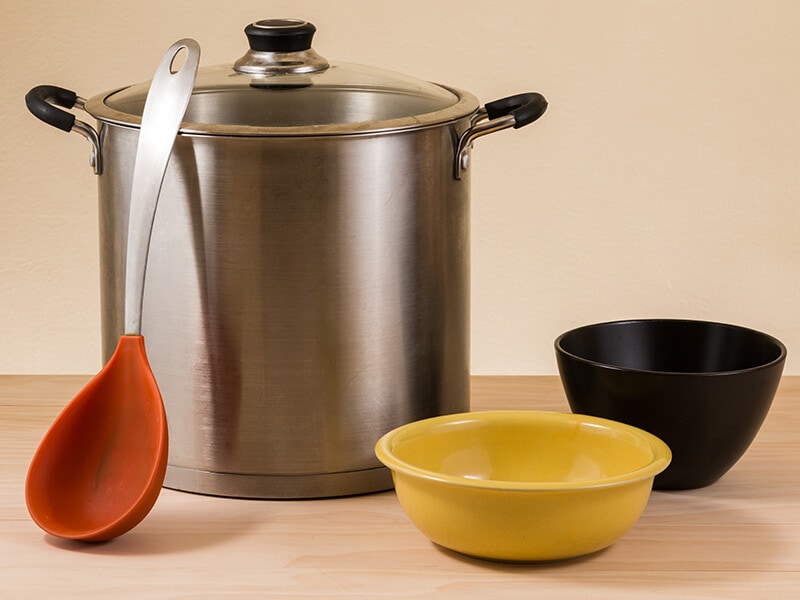
The stock pot has a round neck like other ordinary pots. The flat bottom design and two handles on the sides make it easier to move. In addition, the walls equal to or longer than the base allows you to cook large amounts of liquid and easily stir food.
Today, it is mass-produced and made from modern metals. These include aluminum, cast iron, stainless steel, copper, enameled steel, and even non-stick agents, etc. The pot always comes with a lid (of the same material) with a handle on top.
This type of pot comes in a lot of sizes on the market. The usual capacity is between 5.5 and 11 liters (6 to 12 quarts), though mini stock pots as small as 2 liters are also available.
What Are Stock Pots Usually Used For When Cooking?
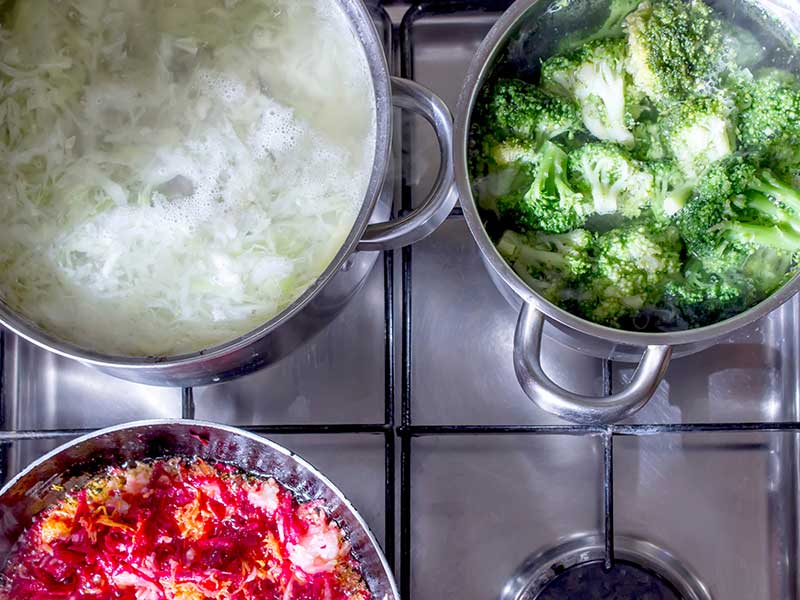
The cooking flexibility of the stock pot will be no less than any other type of pot. You can use it to make a rich broth.
Choosing a vegetable or meat to your liking and cooking it in a stock pot will give you a great soup, stew, or sauce. The good of metal heat dissipation is also suitable for fast or slow cooking.
In addition to cooking water dishes such as porridge, stewing, boiling, and steaming, you have many other options. For example, you can use the stock pot to fry, stir fry, sauté, etc.
Choose The Right Kinds Of Stock Pot To Upgrade Your Meal
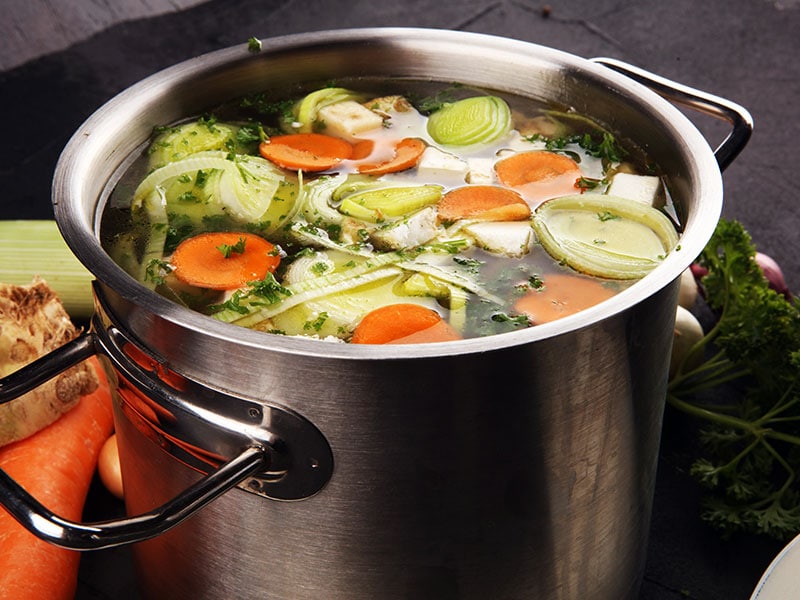
As mentioned above, there are varieties with the shape of the stock pot. Depending on the needs of users, they have designed different pot shapes to serve.
Often, a stock pot comes with two handles. That makes it easier to move the pot when pouring food into the plate. If you just want to cook a little sauce, a small pot will be very suitable.
But in case you have a party at home and need a large pot to cook broths, soups, and stews, choose the large and deep version. The large size will be perfect for bringing the liquid to a boil slowly.
The Similarities Between Dutch Oven & Stock Pot
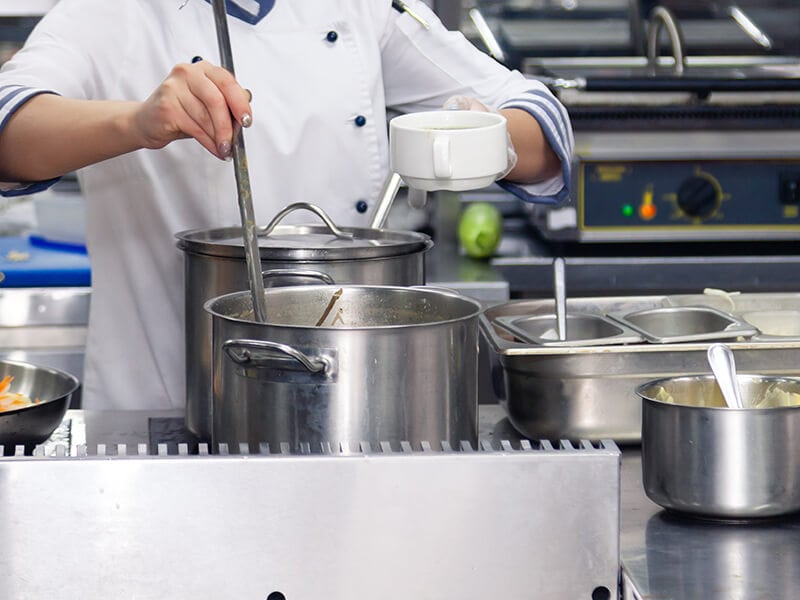
As mentioned at the beginning, the Dutch oven and the stock pot have certain things in common. Many people may think of them as the same. There are good reasons for that. So what is the similarity between the Dutch oven and the stock pot that causes so much confusion?
First, both stock pots and Dutch ovens are used in the cooking of large quantities of food. Although both are available in many different sizes, people still prefer the large version.
Next, due to their construction and materials, they can all be used for slow cooking. Their ability to withstand and retain heat for a long time makes stews or soups more delicious.
Largely, both kinds of cookware are made of metal. Therefore, both Dutch oven and the stock pot are both suitable for cooking on high heat.
If you are not too attentive, it will be difficult for you to distinguish the type of metal your pot is made of. Nowadays, Dutch ovens and stock pots also have aluminum versions. Sometimes you can come across stainless steel Dutch ovens.
The Differences Between Dutch Oven & Stock Pot
Although these two cooking pots are similar, they still have many differences. The similarities listed above are much fewer than the disparities. Take a look at the comparison table below to better understand.
Materials
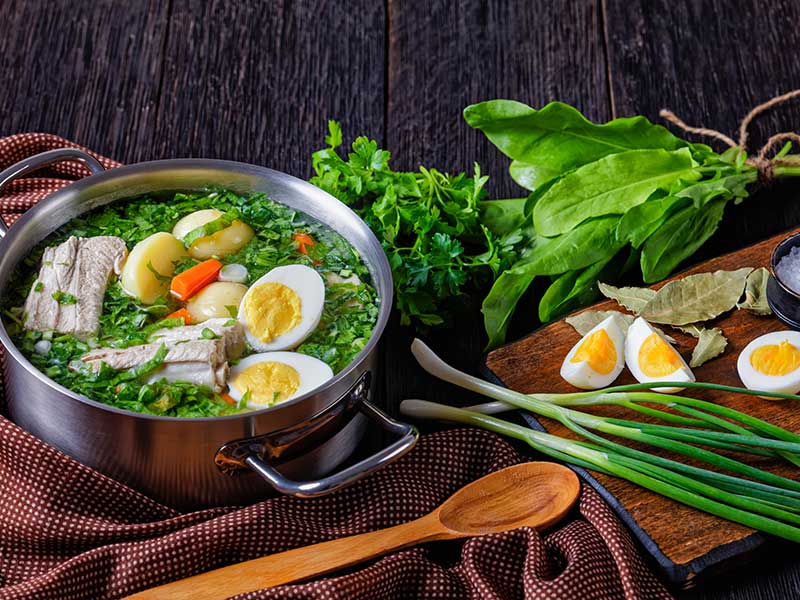
The type of metal used in the manufacture adds different pros and cons to each of these pots. It also explains most of the functional and usage differences between the Dutch oven and the stock pot.
Most available Dutch ovens available are handcrafted from cast iron, enameled cast iron, or aluminum. It is fired for many hours in a “sand mold”. Stock pots, on the other hand, are always made of stainless steel or crafted from copper and aluminum.
In comparison, you will immediately notice that Dutch ovens are considerably thicker and heavier than stock pots. By contrast, the sides of a stock pot are considerably taller than those of a Dutch oven.
Heat Transfer And Heat Retention
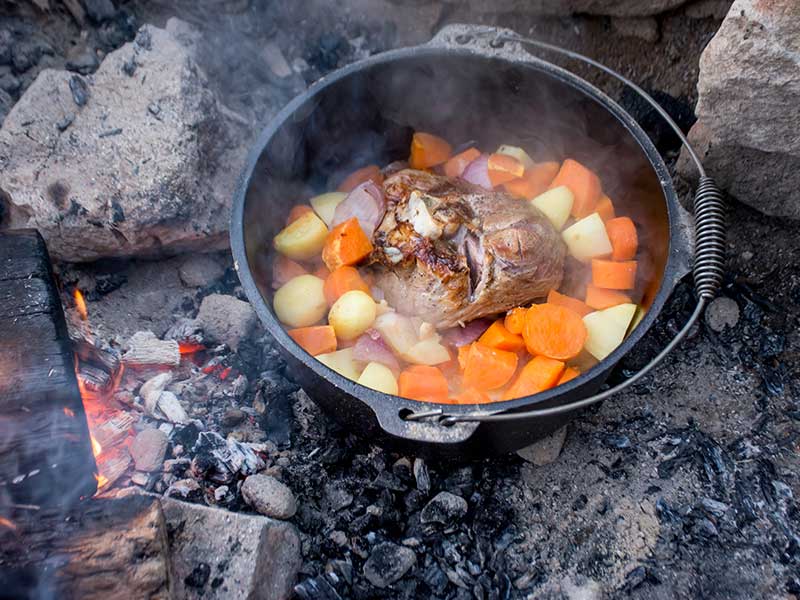
With the structure and bottom, the thinness and overall lightness help the stock pot heat up faster and distribute heat more evenly than in the Dutch oven. Even though they are the same size and use the same level of fire, the Dutch oven needs more time to cook than a stock pot.
However, Dutch ovens have superior heat retention. Due to their thick construction materials and design, heat is kept longer than in other types of pots.
The stock pot can quickly and evenly dissipate heat, meaning that it does not keep food hot for long. The two elements of heat transfer and heat retention always go against each other.
The Size And Weight Of Both Kinds
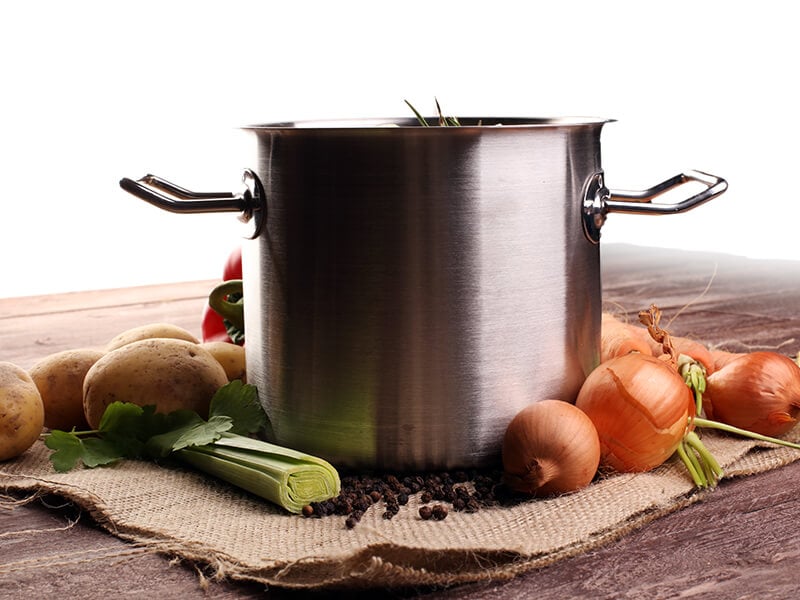
Although you can find Dutch ovens and stock pots of similar sizes, Dutch ovens will always be heavier due to being made from a large mass of cast iron.
Some Dutch ovens are designed to be small to make it easier for users to move. However, the weight will also be higher than the same-sized or larger stock pot.
The lighter weight of stock pots is a perfect advantage. They can fill up with liquid but still easy for housewives to move them on the stove. The Dutch oven is much more inconvenient.
That is also the reason that when using a Dutch oven, you must be very careful. The large size and heavy weight force you to lift the oven with both hands. There are many cases in which improper handling of a Dutch oven results in knocking it over and causing injury to the user.
Ease Of Storage, Cleaning, And Maintenance
Both types of pots are large, so they are difficult to maintain. But the Dutch oven is a little more difficult to clean up than the stock pot. Heavy, wide, tall lids and bulky handles may cause some trouble.
A 5.5-quart Dutch oven can weigh up to 12 pounds. This forces you to place it in low positions. Otherwise, the stock pot of the same weight weighs only about 5 pounds and can be hung or placed on a high shelf.
As for cleaning and maintenance, both types are not too demanding. For enameled Dutch ovens, you can scrub the surface with water, a suitable dishwashing liquid, and a scrubber. However, you must then wipe or dry it thoroughly before storing it to ensure it will not rust or damage.
The stock pot needs to be cleaned with soap and water, too. Grease or food residue on it will easily come off, and its drying time is also much faster.
Spend a little time watching these detailed Dutch oven cleaning instructions to cut down on your cleaning time.
Prices
Both Dutch ovens and stock pots are very easy to find and buy at malls, markets, or kitchenware stores. There is a price difference between these two types of pots. Dutch ovens are usually more expensive than stock pots.
However, due to the market demand, the price of both also varies by brand, material, and purpose of use. You can consider your budget and needs before deciding to buy something.
Use And Versatility Of Dutch Oven Vs. Stock Pot
The uses and versatility of the Dutch oven and the stock pot are different. This depends on its construction and quality.
Use
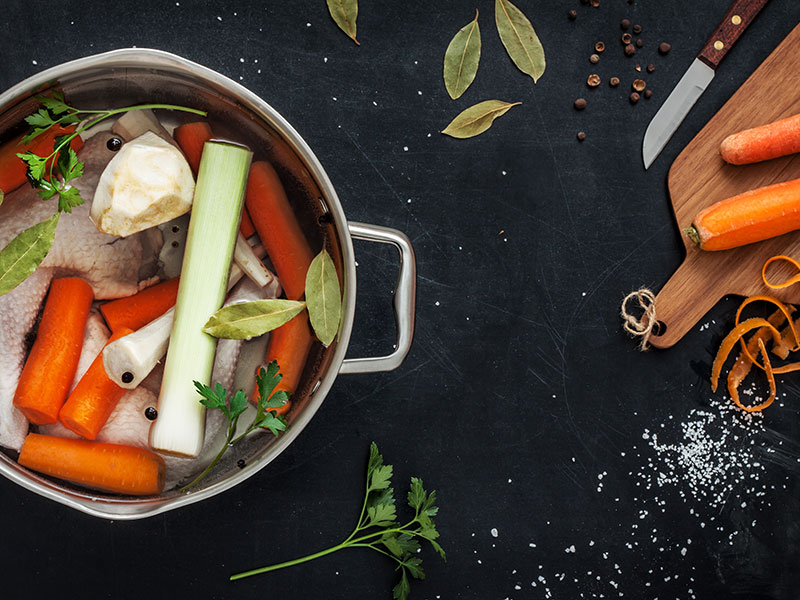
Dutch ovens are designed to be used on both stovetops and campfires. Thanks to its thick and cast iron design, you can use it directly on a high fire.
Moreover, with its high-temperature resistance and wide pot, you can use the Dutch oven for a variety of dishes such as stewing, braising, roasting, soups and grilling.
As for the stock pot, most of them are only safe to use on the stove, except for those made from cast iron. Therefore, they are the ideal solution for stews, stews, soups, vegetables, boiled potatoes or beans, and porridges.
If you use the Dutch oven for the first time on a direct fire, do not worry because it is safe if you do it correctly.
Versatility
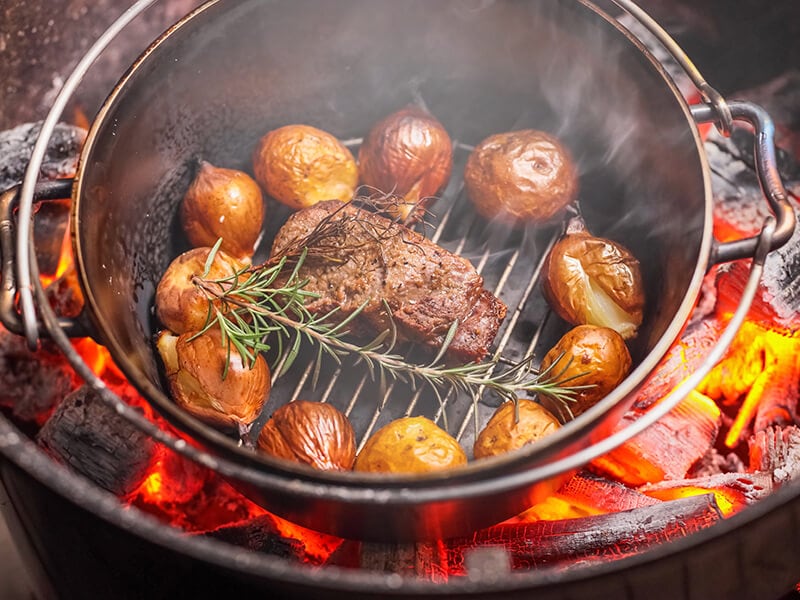
Although the stock pot sounds like it will win the “Usage” battle, it needs to reconsider in terms of versatility,
Many think the stock pot and the Dutch oven can be used interchangeably when cooking. But the truth is a little more complicated than that.
The stock pot is not as thick as the Dutch oven and heats up faster. If you mostly cook on the stovetop or quick cooking, you can easily do it with just the stock pot.
Above all, the type of cooking will determine which type of pot is best suited. Stock pots with thin walls and bottoms may deform when exposed to high temperatures.
Many fires and explosions in stock pots result from plastic handles and glass lids. You can not put things made from plastics or glass in the oven.
On the other hand, the Dutch oven is more versatile. It is resistant to high temperatures and is safe to use in the oven. However, the cooking will take more time.
Next, the Dutch oven is perfect for an outdoor cook or camping person. A cast iron or aluminum pot is suitable for their needs because it can withstand direct flames and cook with coals.
Dutch Oven Vs. Stock Pot – Which One Is The Winner?
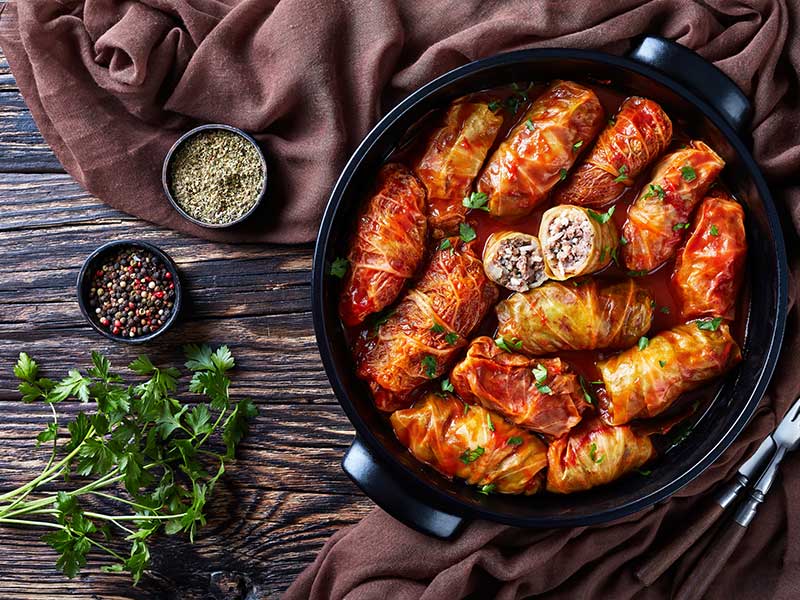
After a series of information and comparisons above, which pot do you think deserves to win this contest more? In my personal opinion, both the Dutch oven and the stock pot are great options for cooking. Their use will depend on different cases and purposes.
Dutch ovens have a few advantages over them. They can be used with open-fire cooking, directly on a charcoal stove, on a barbecue, or with a propane burner. If you want to cook slowly, the Dutch oven is also a wise choice.
Stock pots also have their strengths. With a slimmer and lighter design, they are easy to move, store, and clean. In addition, this type of cookware tends to be more affordable. And as its name suggests, this deep pot is great for cooking stocks.
Both are designed to cook large quantities of food and are often made of metal. Therefore, in some recipes, they are interchangeable. In many households, the use of these two types of cookware is quite similar.
These two kitchen tools rank as one of the most essential and versatile tools your kitchen needs. You can choose from both types to create a range of meals to suit every step of the recipe.
Tips For Increasing The Durability Of Dutch Ovens And Stock Pots
To save time and money, you can follow the suggestions below. They apply not only to Dutch ovens and stock pots but also to many other kitchen utensils.
For Dutch Ovens
Dutch ovens are expensive. Instead of spending extra money buying new ones, you may try these tips to help preserve yours better.
- Heat slowly and use oil or butter: If you heat while the pot is empty, it can lead to glaze cracking. Using too much heat is not a good practice. Add oil or butter to the pot before you start cooking. You should also make sure that the heat is just around the medium.
- Use heat-resistant plastic, wood, or silicone utensils: Many people make the mistake of using metal spoons to mix food in a Dutch oven. This action causes the enamel to scratch and affects the non-stick quality of the pot.
- That isn’t good for your health. When the enamel layer peels off, the metal layer will be exposed, causing you to inadvertently absorb some unhealthy substances.
- Wash by hand: You can still clean the pot in the dishwasher. However, to ensure that the enamel is not damaged, washing by hand is still better. Next, to prevent any excess moisture from accumulating and causing rust, dry your Dutch oven thoroughly before storing.
For Stock Pots
It is troublesome if you have to rebuy your stock pot. Let me introduce some good ways to help you get rid of undeserved mistakes.
- Avoid soaking for too long: If possible, wash the pot immediately after use. Just using a scouring pad and regular dish soap is fine for your stock pot.
- Do not cook acidic foods (such as limes and tomatoes): Acids can corrode metals and expose your pot to significant wear and tear.
- Do not stack: A common mistake is the habit of stacking coated pots and pans on top of each other to save space. But doing so may leave scratches and chips on their surface. Instead, hang them on hooks or put them in cabinets or separate compartments.
Want To Buy A Dutch Oven Or Stock Pot? Choose These Brands!
After what is provided above, I hope you have been able to choose the most suitable pot. At the same time, if you plan to buy a Dutch oven or stock pot for yourself, here are suggestions for reputable pot brands that you can refer to.
Dutch Oven Brands
Here are three famous brands of Dutch oven trade. They have produced products that are appreciated by many consumers around the world.
- Lodge Cast Iron: This is a company specializing in selling kitchen utensils made from cast iron with many designs and colors. The price of Dutch ovens is also diverse and suitable for your budget.
- Tramontina: Tramontina is an international brand from Brazil. With over 100 years of experience in manufacturing cooking utensils, cutlery, and home appliances, I’m sure you’ll find the right Dutch oven for your needs here.
- Le Creuset: Founded in 1925, Le Creuset is a French-Belgian manufacturer of high-end cookware. They are best known for the enameled cast iron products, including Dutch ovens. If your budget is high, try using this product.
Stock Pot Brands
Stock pots are widely sold in shopping centers and online sales channels. You can refer to the products of these three brands.
- All-Clad: With the motto “If you need it in the kitchen, we’ve got it”, All-Clad prides itself on being able to provide everything for your kitchen. They sell from single-stock pots to stackable pot sets.
- Cook N Home: The low price makes it suitable for most budgets. If you are using the stock pot for the first time, you can refer to this company. A reasonable price and stable quality will be a good choice.
- Cuisinart: Cuisinart has been growing since 1971 in the US. In addition to the stock pot, you can find a variety of products, such as knives, scissors, pans, etc.
FAQs
Although providing a lot of information above, you probably still have a few questions. You can refer to the issues related to both types of pots below.
Delicious Meals Need The Right Kitchen Tools – A Dutch Oven & Stock Pot
There is nothing that is designed without its special use. The same goes for the Dutch oven and the stock pot.
After reading the information above, surely you also understand the benefits these two types of pots bring. Depending on yours needs, preferences, and cooking trends, you can choose the appropriate one.
If you find the comparisons above useful, please share this article with your family or friends. Maybe they are also struggling with choosing the true pot for their favorite food like you. If you have any questions to ask, feel free to put them in the comment section.
References
- En.wikipedia.org. 2022. Dutch oven – Wikipedia.
- En.wikipedia.org. 2022. Stock pot – Wikipedia.

